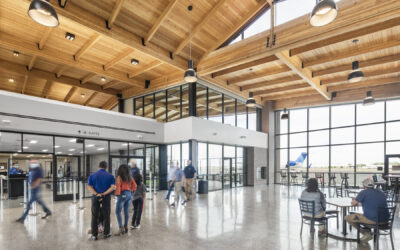Ketchikan International Airport (KTN), situated on Gravina Island in Southeast Alaska, is a gateway to the picturesque Inside Passage and the wider region. The history of Ketchikan International Airport is a narrative of visionary planning and adaptation. Established to meet the growing demand for reliable air transportation in Southeast Alaska, the airport has evolved through extensive development projects aimed at enhancing its facilities and services. From its early days of propeller-driven aircraft to the modern jets that grace its runway today, KTN has continually adapted to the changing needs of the region it serves.
Facilities and Operations
Ketchikan International Airport covers an area of 2,600 acres. It boasts a single asphalt runway that efficiently handles domestic and international flights and one water runway for seaplanes. The airport features a modern terminal building equipped with amenities designed to ensure passenger comfort and convenience, including dining options, gift shops, and lounges. For the 12-month period ending January 31, 2019, the airport had 15,959 aircraft operations, an average of 44 per day.
One of the airport’s most distinctive features is its location across the Tongass Narrows from Ketchikan itself, necessitating an innovative approach to connectivity. The airport is linked to the mainland by one of Alaska’s most unique transportation systems—a ferry service that transports passengers, vehicles, and goods across the water in a matter of minutes, providing an essential link to the city and beyond.
Services and Connectivity
Ketchikan International Airport serves as a hub for several airlines, offering direct and connecting flights to major cities in Alaska and the Pacific Northwest, thus ensuring vital connectivity for business travelers, residents, and tourists. The airport also supports air cargo operations, critical for the supply chain in this remote region, alongside air ambulance and other emergency services, underlining its importance in providing essential services to the community.
Economic and Social Impact
The economic impact of Ketchikan International Airport extends far beyond its immediate vicinity. It is a significant employer in the region and supports a wide range of businesses, from tourism and hospitality to fishing and logistics. The airport’s role in facilitating tourism is particularly noteworthy, with visitors drawn to the area’s natural beauty, wildlife, and cultural attractions, contributing significantly to the local economy.
Socially, the airport fosters a sense of connectivity among the residents of Ketchikan and surrounding islands, bridging distances and bringing communities closer. It facilitates access to medical care, education, and economic opportunities, playing a crucial role in enhancing the quality of life in the region.
Gateway to Natural Wonders and Cultural Riches
For many visitors, Ketchikan International Airport is the first step on an adventure into the wilds of Alaska. The region offers unparalleled opportunities for outdoor activities, such as fishing, hiking, and wildlife watching, set against the backdrop of stunning landscapes. The airport also serves as a gateway to the rich cultural heritage of the area, including the vibrant art and traditions of the Indigenous peoples of Southeast Alaska.
Environmental Stewardship and Sustainability
Operating in one of the world’s most pristine natural environments, Ketchikan International Airport is committed to sustainability and environmental stewardship. Initiatives to reduce emissions, manage waste, and conserve energy are integral to the airport’s operations, reflecting a broader commitment to protecting the unique ecosystems of the region.
Challenges and Innovations
Like many airports in remote areas, Ketchikan International Airport faces unique challenges, including unpredictable weather and the logistical complexities of island operations. However, these challenges have spurred innovation, from the use of advanced navigation and weather forecasting technologies to the efficient ferry system that connects the airport with Ketchikan. These innovations not only enhance the airport’s operations but also serve as a model for remote transportation infrastructure worldwide.
Community Engagement and Future Directions
Ketchikan International Airport maintains a strong connection with the community it serves, engaging in outreach and development projects that reflect the needs and aspirations of the residents. Looking to the future, the airport is focused on expanding its services, enhancing passenger experiences, and promoting sustainable growth, ensuring that it continues to serve as a vital link in Alaska’s transportation network.
Conclusion
Ketchikan International Airport stands as a testament to the importance of air transportation in connecting remote communities, supporting economic development, and facilitating access to the natural and cultural treasures of Southeast Alaska. Through its history of adaptation and innovation, KTN has established itself as a critical infrastructure asset, not just for Ketchikan but for the broader region.







0 Comments